| 1 | Australia’s most endangered snake |
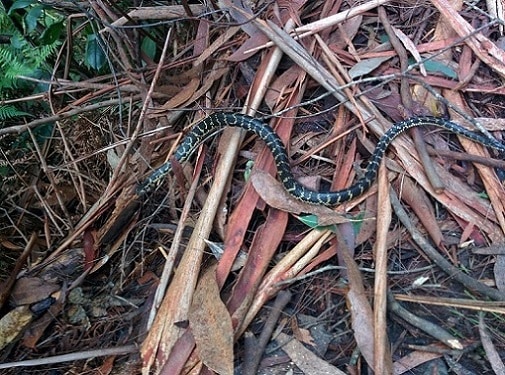
The broad-headed snake is an Australian species measuring 60cm, which is witnessed rarely by ordinarily Australians. This species has a moderately dangerous venom, and is a slow and lazy ambusher rather than an energetic explorer. Compared to the dull eastern brown snake, they’re much easier to positively ID, with a jet black base of scales overlaid with starry white bands. Yet the broad-headed snake has a problem: it’s one of Australia’s most endangered snakes.
The broad-headed snake is found exclusively in a 150km radius surrounding Sydney. They were once found in the suburbs of Sydney itself (including Randwick), but haven’t been spotted in the Sydney metropolitan area since the 1960s.
The decline began in earnest in the mid-1800s, as Europeans constructed ever more towns and cities along the east coast. These days, broad-headed snakes are restricted solely to rugged national parks such as Blue Mountains NP or Yengo NP.
Broad-headed snakes are endangered for various reasons, but the main reason is their extremely specific habitat requirements. They require rocky sandstone outcrops amidst open ridges in forests, the sort of place you might stop for a picnic and admire the view. They require dark crevices in these ridges, and loose rocks lying on the surface which they can hide beneath. Finally, they have a strong preference for southeast-facing ridges, which maximise their sun exposure during cool winter afternoons.
| 2 | Lives a lazy life |
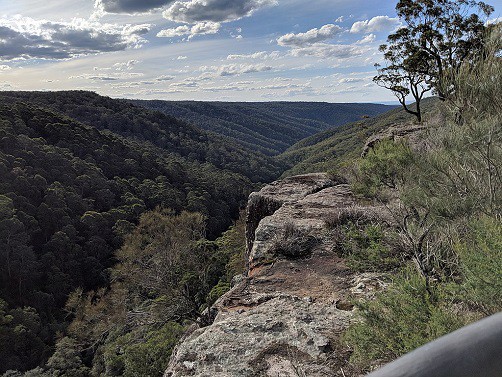
Broad-headed snakes require not just rock, but “rock on rock”. They’re rarely found in rock slabs resting on soil, or grassy clearings. It has to be sandstone rock slabs resting on a ridge rock base – nothing else will do. In summer, broad-headed snakes venture further afield, slithering around forests adjacent to their ridges, but without these ultra rocky sandstone outcrops, they cannot survive winter and spring.
These rocky outcrops are also important for their hunting style, which is purely ambush. Rather than exploring aggressively for prey, broad-headed snakes lurk comfortably under a warm rock and wait for oblivious reptiles to pass. Then they lunge in an explosion of speed, defying the motionless statue they’ve been imitating.
Broad-headed snakes begin injecting their venom, and never let go of their prey until all struggling ceases. In the meantime, they press the prey against a hard rock, clamping it down, or less commonly apply a couple of constricting coils. Broad-headed snakes can remain motionless in a dark crevice for days, or even weeks.
| 3 | Threatened by bush rock poachers |
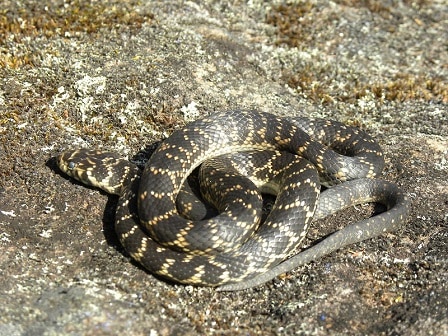
Broad-headed snakes have strongly declined, and habitat destruction is the main reason why. The problem isn’t just national parks being absorbed by agriculture, but something more specific – the theft of natural bush rock, often scraped directly from their remote ridges.
Bush rock is a wildly popular ornament in the gardens of Sydney, and has been for over 150 years. It’s designed to mimic the ruggedness of the wilderness, but with home comforts metres away, with all the usual competition to see who can have the fanciest garden.
You can buy legal sandstone boulders, but it’s equally common to see flatbed lorries speeding away from Sydney’s national parks, sheets of flat rock strapped to their backs. Opportunists will park along national park roads, walk a few hundred metres, and begin stripping the natural rock from ridges. This is now illegal, as it ruins natural bushland habitats, and there’s no better example than the broad-headed snake. Many lorry drivers have been caught and prosecuted, but others fly under the radar.
| 4 | Threatened by hikers |
The broad-headed snake has such delicate requirements that pinching even small amounts of rock can wreak havoc, causing them to vanish. However, ignorant hikers are also a problem. Their exposed rocky ridges are the perfect site for a roaring campfire, and many explorers shift loose rocks to create cairns. Also, the snakes’ rocky outcrops are inherently more likely to be near walking trails, because of the excellent views they offer.
The biggest remaining base of broad-headed snakes is Morton National Park, where they can reach concentrations of 33/km. Wollemi National Park is their most untouched hotspot, as it’s so remote that hikers and rock poachers cannot reach certain areas on foot.
In a 2005 study, researchers flew into the depths of Wollemi using a helicopter, and fought their way to the rock ridges. They found that broad-headed snakes were still thriving in these areas locked away from mankind’s influence.
| 5 | Simple to recognise |
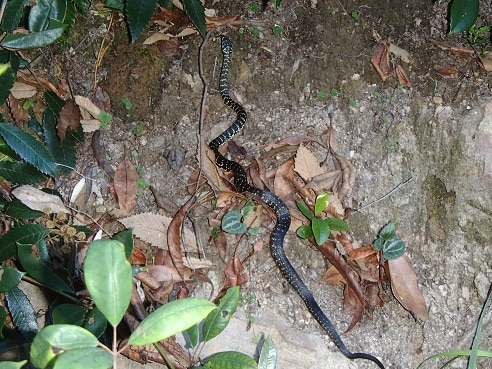
If you’re lucky enough to find their secret ridges, then you work is complete, as broad-headed snakes are very simple to recognise. They have a black body overlaid with small white blotches, which sometimes join to form thin bands, but rarely cover much of the body.
The maximum length for a museum broad-headed snake is 75cm, though one scientist reported an 87cm snake from the wild in 1981, out of 100 measured. Broad-headed snakes are much darker than their fellow family members, the pale-headed snake and Stephen’s banded snake. All family members have a slender body followed by a wider head.
The biggest lookalike of this species is easily the diamond python. This is a subspecies of the common carpet python which is centred around Sydney, and has midnight black scales overlaid with vividly contrasting yellow spots. The difference is that broad-headed snakes have a consistently grey belly, with no patterns. Diamond pythons have a pale belly, matching the colour of their light blotches, with occasional black markings scattered about. Up close, diamond pythons also have labial pits near their snout for infrared heat-seeking, which broad-headed snakes lack.
| 6 | Venomous, but easily treatable |
Broad-headed snakes are venomous to a middling level. They’re neither the harmless chewer of a garter snake, nor the kidney-melting horror of a Russell’s viper. Its venom primarily causes blood clotting chaos, but is a procoagulant rather than anticoagulant. Instead of disabling blood clotting by destroying the ingredients, Hoplocephalus bungaroides causes mass activation of fibrinogen and fibrin. Eventually, this depletes clotting supplies so far that normal clotting of wounds becomes impossible. This is called Venom induced consumption coagulopathy (VICC), and is the also the route taken by its Hoplocephalus relatives: Stephen’s banded snake and the pale-headed snake.
Broad-headed snakes also have mild neurotoxin dangers, including slurred speech, drowsiness, and weak muscle control. The free bleeding can kick in less than one hour after being bitten. This snake lacks a dedicated antivenom, but luckily, Australia’s standard tiger snake antivenom works like a charm. One one death has ever been recorded.
Broad-headed snakes have a highly strung personality. When bothered, they shift into S-shaped coils, and snap at intruders with a vicious gleam in their eyes.
| 7 | Teeters over cliffs |
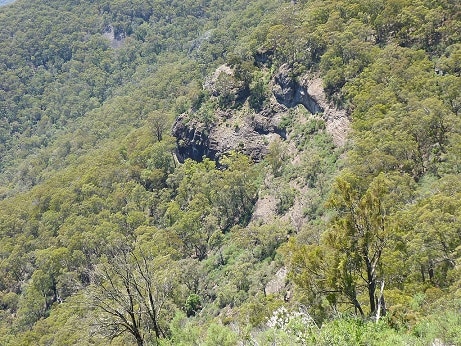
Broad-headed snakes are often found with a pair of neighbours in their rocky outcrops: the small-eyed snake and yellow-faced whipsnake. These species thrive among sandstone bushrock, yet are barely affected when thieves remove it. Only the broad-headed snake suffers.
In these rocky environments, Hoplocephalus bungaroides tends to stay closer to cliff edges than other snakes. They can rest on severely steep mountainsides and even survive snowfall. Winter is their laziest time, spending much of the day resting on rock slabs, basking in the unending cool sunshine. The crevices they lurk in make finding them difficult even if you’ve reached the correct sunny ridge. A 1998 study only managed to find 11 broad-headed snakes over 54.5 hours, equating to one snake ever 5 hours.
Broad-headed snakes travel very little distance, moving less than 1km from the rocky crevice of their birth. They more than match the laziness of an emerald tree boa, except that they lurk in rock crevices rather than rainforest branches.
| 8 | Favourite prey: velvet geckos |
The diet of a broad-headed snake shifts with age. As youths, they’re dependent on velvet geckos, a 10cm species which also loves rocky ridges, and the most common gecko in rural Sydney. As Hoplocephalus bungaroides grows, it still primarily eats reptiles, but diversifies to eastern water skinks, and mammals such as the house mouse and brown antechinus. They keep their taste for velvet geckos, though in dramatically reduced proportions.
Velvet geckos are yet another chain that holds the broad-headed snakes in place. Without this species, they cannot thrive at all. A 2005 study found that broad-headed snakes were clearly most abundant at the rocky ridges where velvet geckos also thrived. Velvet geckos have evolved in response to this hungry predator, learning to avoid the broad-headed snake’s scent. This is probably why they’re an ambush predator, as less travelling means less spreading their scent around.
Broad-headed snakes have their own dietary niche to some extent. They share their rocky ridges with small-eyed snakes, another reptile muncher, but this species mainly relies on skinks, skipping geckos entirely, for mysterious reasons. This leaves a wide open buffet for broad-headed snakes to enjoy.
| 9 | Can’t replenish itself |
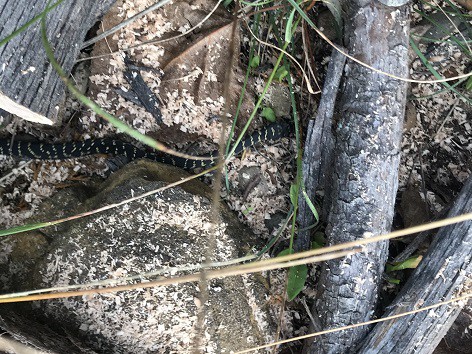
Yet another characteristic that makes broad-headed snakes endangered is their breeding cycle. This rare species reproduces very infrequently, and matures at a late date. A large percentage of females don’t breed every year. In a study from Morton National Park, only 3 out of 7 females monitored were pregnant in 1992, 2 out of 5 in 1993, and 2 out of 8 in 1995. None of the tracked females reproduced more than once over the 4 year study.
Broad-headed snakes may be the slowest reproducing of any Sydney snake. This is linked to another secret characteristic: that broad-headed snakes are an infrequent feeder. A particularly large proportion are found with no food in their bellies, reducing the energy they can expend on reproducing. The brutal reality might be that they’re inefficient, and evolution has left them behind. Or it’s possible that this slow nature wasn’t a problem until mankind moved in.
Consequently, broad-headed snakes can’t order a mass breeding cycle to replenish depleted outposts. The recovery of individual rocky ridges happens only slowly.
| 10 | Why hope remains |
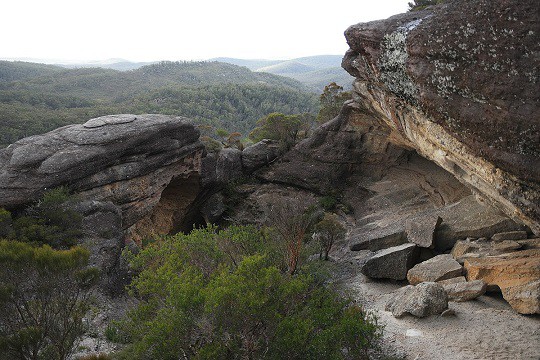
The most adventurous time for broad-headed snakes is summer (December-February). This is when they finally leave their rocky outcrops, and venture to nearby forests, occasionally stashing themselves in tree trunk hollows where they continue the ambush game. Broad-headed snakes are spotted on roads occasionally, one being Woronora Dam Road, near Darkes Forest south of Sydney.
Broad-headed snakes happily gobble up pinkie mice in captivity. They’re one of the easier snakes to keep – just fling them a hairless frozen mouse and they’ll love you. One snake enthusiast kept a broad-headed snake for 19 years on a diet consisting mostly of mice.
New South Wales lists the broad-headed snake as “endangered”, though some believe that they’re more widespread than previously believed. Estimates range from 10,000 to 100,000 surviving in the wilds of Sydney. One boast is being totally immune to wildfires. In bushland devastated by flickering flames, the broad-headed snake emerges unscathed, probably because they vanish into dark crevices so effortlessly.
